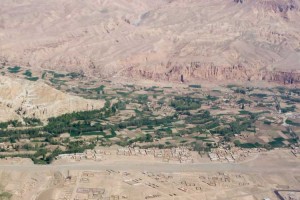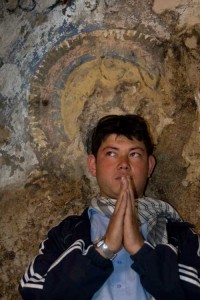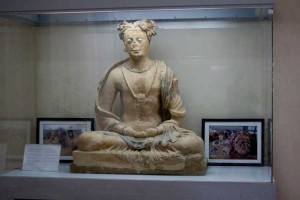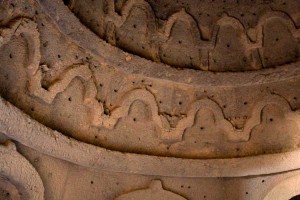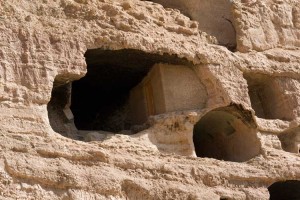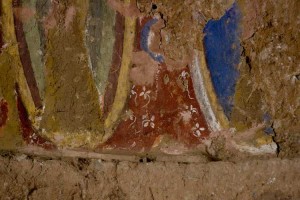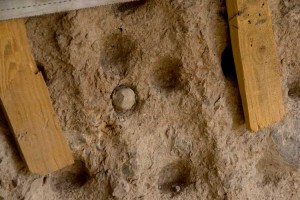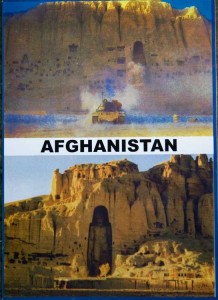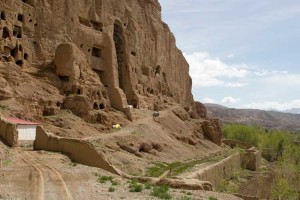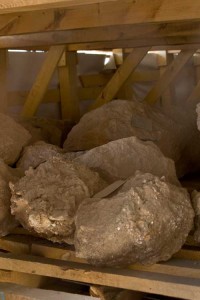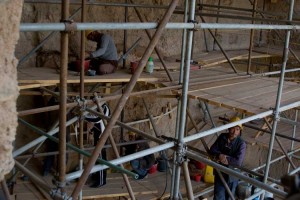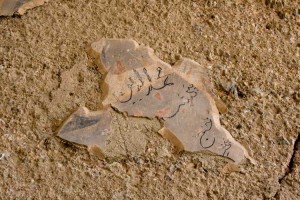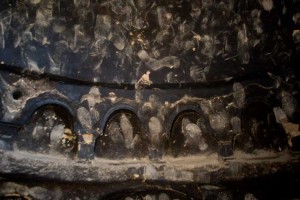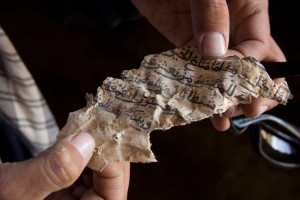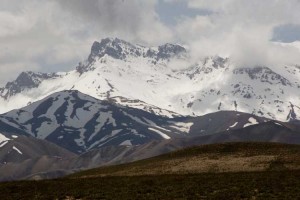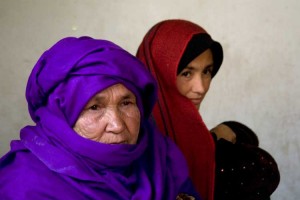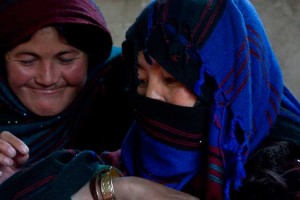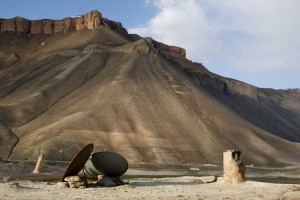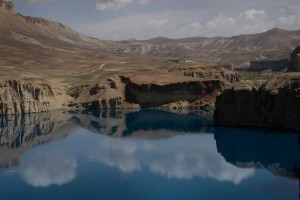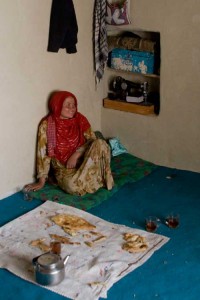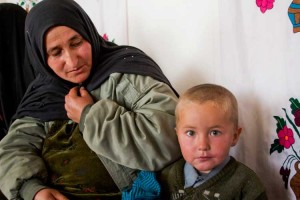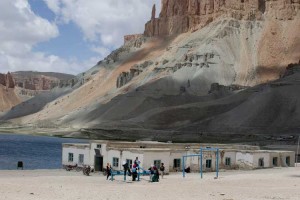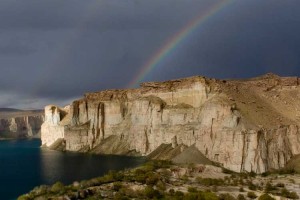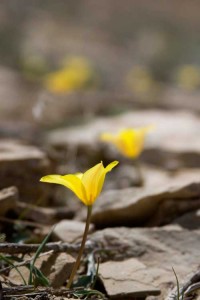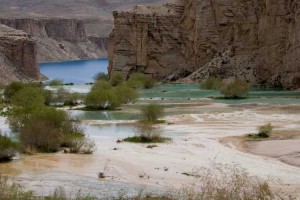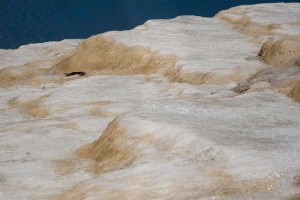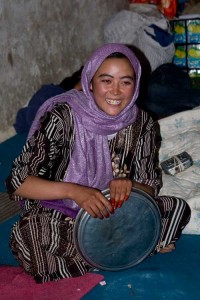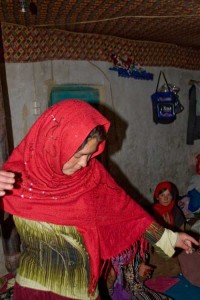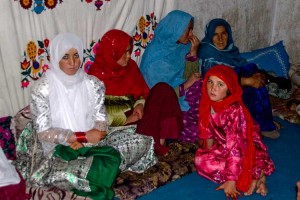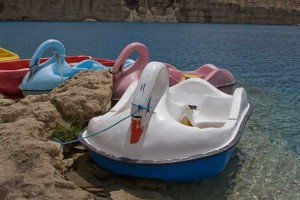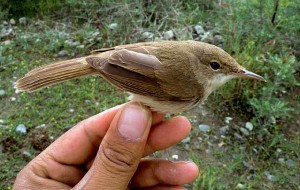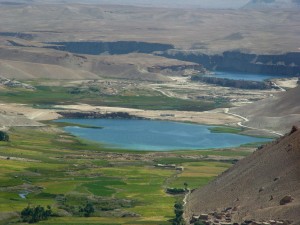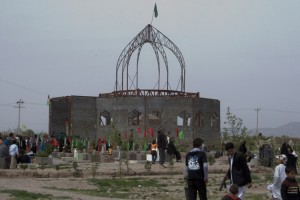Bamiyan Part 2
June 4th, 2010
[Sorry to take so long to get this post up. Now I’m back in Austin and beginning to go through my interviews and photos. It’s a mountainous task! I will continue to write as I go through this process.]
Bamiyan means “shining place”. It’s holy for Zorastrians as well as Buddhists.
The cliff with the “Buddha caves” dominates the landscape of Bamiyan City. It runs along the ancient Silk Road between the the Hindu Kush and the “Baba Mountains”.
Abbas, a well-versed guide from the Agha Khan Foundation cultural Center, showed me around.
Bamiyan was chosen by the Hephthalites as the place to settle because of the mountain barriers and strategic defense points overlooking the valley, it’s location along the Silk Road and the conglomerate cliffs that could be easily carved into housing.
The worst war (of the Soviet, civil and Taliban) was the one with the Taliban. There wasn’t so much fighting during the “Russian times”. The Soviet army perched on the few high places and easily controlled the area but mostly, people were allowed to live their lives. The Taliban period was quite bloody, however, as here the conflict included racial animosity (Hazara vs. Pashtun) as well as a fight between the Sunni Taliban and the (to them) heretical Shia. Hazara fighters holed up in the caves, which had inner passages from one to the other. 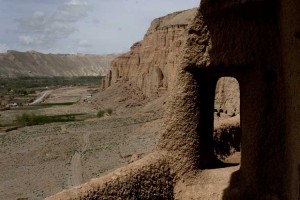 In some areas, water was also channeled inside. During and after the wars, 3000 or so families were living in the caves which kept them cool in the summer and relatively warm in the 6 months of harsh winter.
In some areas, water was also channeled inside. During and after the wars, 3000 or so families were living in the caves which kept them cool in the summer and relatively warm in the 6 months of harsh winter.
I was surprised to find that all of the 12,000 caves in the Bamiyan area are man made, the ones along the “Buddha cliff” hand dug at first by the Buddhist monks, and later by regular people to make their houses. Buddhists begain moving into the area in the second century and by the 5th century, 2,000 monks resided there
It took a full century to carve the Buddhas. The large one was covered with gold and diamonds and both were painted. They found heads of small Buddhas and small stupas below the wall with the Buddhas.
This excavation progresses in June and July when Professor Tarzai is free from his teaching duties. When he’s not there, the site is lined with plastic and filled in with dirt. 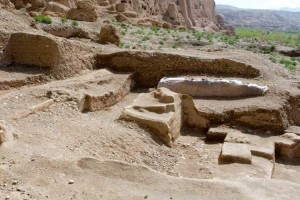
In Greece and Rome they found copies of a map of Bamiyan. It mixes Greek, Indian, Byzantine, Iranian Sasanid and Chinese architecture. It was made at the same time, using the different styles.
In this place with doors locked by UNESCO, the paintings are even better. The blue color was made of ground up lapis lazuli stones. The green was colored by a tree, yellow from herbs, and poppies made the red. These colors were mixed with either walnut or poppy seed oil. These date from the 5th to the 9th centuries, before oil painting was done in Europe.
Most of the Buddhas statues were just carved out of the soft stone cliff, but parts of them were modeled using a plaster of mud mixed with straw. The arms, which were also added, were secured in place with these
pock marks” which allowed the mud-glue and wooden pegs to adhere to the sides of the grotto.
The Taliban had a hard time destroying the Buddhas. First they shot at it, and when that didn’t work, they used dynamite. They blew charges three times a day. It took 1 week to destroy the small Buddha which was made of softer material and it took a month to destroy the large one.
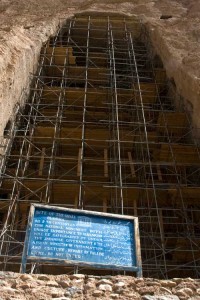
Once the Buddhas had been blown up, a lot of the rubble has now returned to dirt.
The plans are to do a partly fragmented reconstruction.
Here they are stabilizing the rocks. In this phase of the reconstruction, they are painting the rocks with chemicals to help solidify them.
In addition to destroying the Buddhas, the Mujahadin and Taliban also added their graffiti to the paintings
and had fun in the kitchen putting footprints on the ceiling.
As we were walking through the caves, Abbas found this crumpled handwritten piece of the Koran stuffed in a crack in the wall. We stopped at the tourism dept. on the way out to turn it in. They don’t know the exact date yet, but it may be several hundred years old.
Posted in Afghan Women's Project, archeology, environment, Other, tourism | Comments Off on Bamiyan Part 2
Places
May 14th, 2010
My breakfast table,
Facing a bed of deep-red, pink-magenta
And pale-tinged roses,
The peaceful breeze caressing my back
Birds calling out
A plate of two sunny eggs,
Flatbread and green tea before me.
Who would think I’m in Afghanistan?
****
All alone, carefully hidden in my tiny cave
While thunderous explosions
And flashes of light
crash around me.
Their deafening roar brings excitement
As I gaze across the impossibly deep-blue lake
Through the curtain of riotous rain.
When the deluge subsides
And I finally crawl out of my rocky shelter,
I’m met with a fully arched
Double rainbow.
Double blessings.
Double happiness.
And to think that I considered
Turning back at the first sight of clouds.
Posted in Other | 2 Comments »
Bamiyan Province, part 1
May 13th, 2010
Hazarajat, the central highlands of Afghanistan
is home mostly to the Hazara people, those who are descendants from Central Asia, including Genghis Khan’s destructive hordes. For the past two weeks I’ve been visiting a few of their communities in the province of Bamiyan. I’d been invited by LEPCO to visit their Leprosy and TB clinics in Yakolang (and Panjao, (meaning Five Rivers) but the roads were flooded with the spring snow melt and rain.) As all villages and towns in the area, it is long and narrow, following the course of the river. 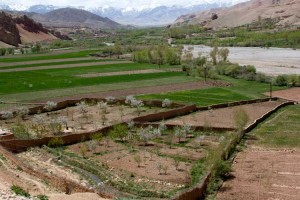 LEPCO has a different policy from other TB NGOs in that instead of just handing out the TB medicine, they collect the patients from their homes and bring them to the clinic so that they don’t spread the disease further while being cured. They feed and house the men and women for two months until the bacillus is no longer visible in their solar-powered microscope. I talked with a few of the women.
LEPCO has a different policy from other TB NGOs in that instead of just handing out the TB medicine, they collect the patients from their homes and bring them to the clinic so that they don’t spread the disease further while being cured. They feed and house the men and women for two months until the bacillus is no longer visible in their solar-powered microscope. I talked with a few of the women.
Many are from impoverished remote areas and they brought very little with them. They sat around all day waiting for their food and another day to pass. They asked me for help to improve their lives. TB spreads so quickly among these poor people because their diets are so deficient. The questions I came away with are how to help Jawad, the LEPCO director in his personal quest to aid these women. (and men. Although I didn’t talk with any of them, their problems are similar—lack of income in these areas where farming is so marginal.) One thing I’m looking for now is an organization who is willing to piggy-back on LEPCO’s infrastructure to provide a teacher (someone from among the educated in Yakolang for the Yakolang clinic, etc.) who can help the women utilize their time with some sort of an educational program. The other thing I’m working on is some sort of income producing activity that can bring in some badly needed cash. Right now, it’s looking like a carpet weaving project might be the most effective. We’re scratching our heads for other ideas.
From there I spent four glorious days in Band i Amir National Park. (Band means lake) The hotel wasn’t open for the season yet, so I stayed with Bulaghi and his family. Since there is no phone service, I just showed up—carefully stepping on the single stones that formed a pathway up the squishy wet hill that oozed with water leaking from the canal above. They opened their living room to me and I made myself at home.
The following day, Bulaghi, who speaks some English, informed me that he was leaving for Bamiyan that afternoon and that I was welcome to stay if language wouldn’t be too much of a problem. I settled into a routine, hiking in the morning, coming back for lunch and a rest, hiking again in the afternoon, returning for supper and electricity to process the day’s pictures. It was amazing how my pictures broke the ice, and Sabina and her kids looked forward to my return so they could see how I saw this area they’d grown up in all their lives.
Pictures opened doors that first afternoon as well when I was invited to attend the first birthday celebration of the village midwife’s first child.
I was welcomed into a room filled with about 20 women and a few children. The midwife spoke some English, so we could get the basics out of the way—I’m from America, married, 58 years old, and my daughters are 26 and 24. I asked if I could take pictures and they excitedly agreed. I’d take a few and then they would crowd around me to see the results.
It was great fun. I loved that on this trip, in this small village, I could collect the images of them on a flash drive and transfer them to the midwife’s computer.
On my second day I visited a school. In all of the schools I’d encountered the school day lasted a half day or less. In this school, there were two morning shifts. I talked with some of the teachers and it seems that nearly all of the children from the three nearby villages attend school. They study science, history, math, Islam, Dari and English. There are about 70 students from three villages and 15 teachers, most educated in Iran during their exile there. Many of the villagers I met enjoyed living in Bamiyan (or never thought about not living there) but some of the teachers felt stifled out there in the hinterlands and longed for a more stimulating life.
The hiking was great. After two months in Kabul with it’s horrific air pollution, ubiquitous soldiers and guns, an inability to walk anywhere and a struggle to remain fit by running up and down the stairs of the SOLA house, this opportunity to be out in gorgeous nature and walking for hours (one day 8 hours) alone was just what I needed.
The weather was chilly but would warm up by late afternoon. By mid afternoon, roiling thunderstorms would saunter in bringing brief showers and then move on. One day when they started to come, instead of turning back, I decided to do what an Afghan would do—find an outcropping to wait it out. When the first heavy drops began to fall, I found a small shelter with a good view of the lake. When I finally crawled out, before me, on the opposite side of the lake was a wall of black clouds from the storm that had just passed and a fully arched rainbow, with a bit of a second one as well.
On my way back, I used the plastic bag I’d brought with me to start picking up trash. I quickly filled that and half of a giant bag that I’d also found among the weeds. Since I’m always on the lookout for
flowers, the sight of trash was especially noxious. As I arrived at the row of stalls, one of the shopkeepers called me over and I showed him what I’d been doing. A park ranger was also there and began saying how bad Afghans are for trashing their park, but I explained that they aren’t bad, just unaware, (There are trashcans about, and the tourists are pretty good about using them, I think; it’s mainly the locals who have no sensibility about it.) and that since they had grown up with trash strewn about, it was like the myriad rocks and went unnoticed. I told them that Band I Amir is a world-class park, if only the trash were removed, both from the park and the village (where the visitors stay). He offered to accompany me the following day and we both set out on a fun adventure, collecting 4 bags on the way. Because he was guiding me, we crossed the Band i Panir (Panir means cheese) Calcium deposits,
waded through the flowing streams, and climbed up the other side.
That night, exhausted, just as I was ready to get into bed, a group of 5 women came and insisted that I join them at a party for their recently married friend who leaving the next day to join her husband. When they told me I should take pictures, I jumped up.
This party was the worst of the old and new. When we arrived, everyone’s eyes were glued to the TV set which had some American adventure program dubbed in Dari. When that finished, they tried to get the DVD player to function and a young boy spent a half an hour working on that while the women just sat around and dealt with the babies. Another woman was trying, without success, to get a tape player going. Meanwhile, one woman started beating a rhythm on a tea tray and several got up and danced,
(myself included, of course), but after a short while they gave up to wait for the technology. After close to an hour, the DVD player sprang to life and a few more women danced, one at a time, to a Bollywood version of MTV. By that time, it was late and we headed back home. Had there been no technology, there would have been dancing the whole time, likely with an instrument or two.
As for the bride, she sat there glum-faced the entire time.
The following day, a group of Belgians from the NGO, Mothers for Peace which has some excellent projects in Istalif, a picturesque village outside of Kabul, came to visit the lakes and bring me back to Bamiyan. I’m so glad I had changed my original plans and chosen to make a longer trip because they had a picnic on one side of the lake, drove around to the opposite side with the shrine and swan boats,
had a ride in them and we left.
Posted in Other | 2 Comments »
The Peace Jirga
April 23rd, 2010
The London Conference, which took place in January of this year to chart a new course for the future of Afghanistan, established a Council Circle (jirga) about Peace, scheduled to take place in early May. (It’s since been postponed to the end of the month.) Fifteen hundred of Afghanistan’s tribal elders and other community leaders are to be brought together (paid for by the UN) to create a formula upon which peace can be built. In order to establish meaningful peace, all parties would need to be involved, including militants of different varieties.
The reaction of the Afghan Women’s Network was to host an Afghan Women’s Forum on April 3rd where influential women from all over the country came together to discuss the participation of women in the Peace Jirga. There were lots of nice speeches but in the Q&A afterwards, when asked how women should be included, one male panel member suggested that women select one representative to be present at the Peace Jirga to let the participants know what women think. This, of course was shot down by the audience, and in the end, he agreed that 30% of the attendees to the jirga should be women. What else could he say? He was only a representative for the minister who hadn’t attended. If he truly supports significant female involvement, he will have to push for it. Otherwise, he could let it sit on the back burner and nothing would come of it while he could still claim to be “supportive”. The position of the Forum was that women should also be substantially involved in each of the “clusters” (of ministries) which would lay the groundwork for the jirga.
Vic Getz,(1) who has been involved in Afghanistan for five years and living here for three has this to say about the Peace Jirga:
“If these media photo ops are happening at taxpayer (I mean around the world) expense, then we must create mechanisms to invest in parallel conferences that provide alternative points of view. …to be constrained by the powers that invest (??) in Afghanistan is unacceptable. Fund the Parallel Peace Jirga….start it now. Where is the money for these kinds of initiatives? Where is the support? – Because I KNOW, that the people, ideas, intelligence, understanding (far more nuanced than you could ever believe), networks and energy are here. Now. Today.
If I had the money, I would fund it myself – just to show the world the Afghanistan that I know exists here. Now that’s a photo op I could believe in.”
I’ve been asking my interviewees their opinion of “negotiating with the Taliban”. The responses seem to be divided into two classes. The “normal people” (both those who left and those who suffered under the Taliban) have mostly said that you can’t trust them, that they are all against education for girls and that if they are allowed into the government, the situation will return to what it was before. The women who are members of Parliament or leaders of some women’s groups say that if Talib individuals are to become part of the government, then they must abide by the rules of the constitution in which women’s rights are clearly stipulated. And so they think that it’s not a bad idea and that it might have a chance of bringing peace.
One mistake that I see in this discussion is the assumption that all Talibs are the same and that they are unchangeable. Even under their previous rule, there were different strains of them under different leaders. Some were more ideologically motivated, others were members because they needed the pay, others because they were supported by Pakistan. Now there is also talk of them having changed their tune a bit. Mullah Omar released a statement last fall saying that “the Taliban do not oppose women’s rights and favor education for all”.
Tajwar Kakar told me this story when I interviewed her in 2003 talking about the time when she was headmistress of a school for boys in 2000 under the Taliban.
“The next day the religious police came to my office and I asked them what they want. They said that they heard that I have one room where you put pictures. I opened the door and showed them the two walls of pictures, one group of pictures of the city before the war and the other of the destroyed city. Look, I said, who destroyed our country? Who made you poor? Who made you uneducated? Before the war, you had a good life and there were nice buildings. Now it is not your responsibility to take your stick and punish the woman. Now you should build up your country. I put these pictures to put in their minds who destroyed their country and what it is their responsibility to do.… What are you doing now? Have you come to punish me? He said ‘you did nothing wrong’. How old are you ? ‘We’re 18, 19 and 20.’ How will you rebuild Afghanistan? With this stick you have? Islam doesn’t teach you to punish the women. Then one asked: ‘Is it possible for us to come every day for a half hour and you will teach us?’ They had come to punish me. But that was my work.”
Hanifa Safia, the women’s-affairs representative for the province of Laghman, says that she thinks “a settlement is the only way to peace. The Taliban fighters who throw acid on schoolgirls’ faces or threaten professional women do so just to antagonize the government. I have talked to so many Taliban. They are not against women,” Safia said. “Once they have been given positions in government, they will definitely change.” (2)
On the other hand, Hekmatyar’s organization, Hezb-e-Islami, the second largest insurgent group, is calling for the replacement of the current Afghan parliament with an interim government which would, after new elections, rewrite the constitution. Scary.
As far as women being forced to stay home and being denied education and human rights, the biggest factor is the families. Now, at a time when the government gives women all of these things, many fathers, husbands, brothers and even sons deny them to their women. It is important to have the legal rights and educational opportunities, but the real work of social change must happen on an individual level and must be seen from a generational perspective.
One powerful force (especially in Afghanistan) in this endeavor is Islam. The rights for all of these are given in the Koran. Already much progress is being made through education, basing the good treatment, respect, education and involvement of women in society on Islamic scriptures.
1 Vic Getz,PhD, is an Environmental Sociologist/Gender and Development Specialist and founder of the Afghan Gender Cafe (UPGRADE coming soon)
To join the AWRL (Afghan Women’s Rights List) network, email Vic at vgetz@moscow.com
2 By Karin Brulliard The Washington Post
Posted in Afghan Women's Project, AWP 2010, education, Other, political | 1 Comment »
Afghan Women Writers
April 16th, 2010
The Afghan Women’s Writing Project offers a way to support Afghan women emerging writers in a delightful, eye-opening and very meaningful way.
Novelist Masha Hamilton began this project to give voice to Afghan women. The deteriorating opportunities for women from her first visit in 2004 until her return in 2008, inspired her to create a project where women could share their thoughts from the safety of their own homes, unfiltered by family members or the media.
Women who join the project are mentored, via back and forth emails, as they polish the writing of their experiences. Many of them participate in secret. Their mentors, female authors and teachers, volunteer on a rotating basis. Writing workshops are taught in online classrooms.
I have met and interviewed several women in this project and will be sharing some of their life stories in my presentations upon my return. Some of the most promising of these writers have told me that they came to believe in their writing abilities due to the supportive comments left by readers on the pages of the website. These poems, short stories and essays provide a window into the lives of Afghan women that we would not have otherwise.
For example, one woman writes:
Let the world know
I am a poem.
My soul is crazy.
no matter what happens next,
no matter if no one reads the verse of my mad thoughts,
no matter if dust covers my poetry papers,
I am a poem.
I write about the waves of my soul’s water.
My poem tastes like a glass of black tea
when you are tired.
It is the spice of my lunch every day.
My poem sounds like the sky singing in summer,
like rain in the spring.
My poem sounds like
parrots talking, sparrows chatting
in a lonely tree in the valley.
I bloom, bloom, bloom.
When I write about mirrors
pain, life, tea, sparrows, eyes,
I write, write, write.
No matter that, in her hands, Nature
has a hammer, leveled
at my head, poised to kill my poem.
I don’t give up.
I am a poem.
By Roya
And another:
While the schools Burn
“I am burning,”
says the school.
“Who will save me?”
cries the school.
“Where are my students,
the teachers, our friends?”
“Why do the Taliban burn me?”
They are not literate.
Students fear.
Teachers receive threats,
get kidnapped, beheaded.
Friends, families fear.
Unread books are sad.
They too, burned
by guns that write with fire.
Knowledge, understanding
grieve.
Is there anyone
any organization
any country
any international society
who will help us overcome our loss,
this war,
our Afghanistan?
We wait, hope, want.
Please, help us
invite the return of knowledge.
By Freshta
Below is an excerpt from an essay written by a woman returning to her home in Mazar Sharif:
Who Will Stop The Crimes?
…After leaving Fatema’s house, I saw a small girl trying to clean a car. People on the street were laughing at her. I thought: Why is she on the street? Why isn’t she studying instead? How can I take them out of the darkness? I know I alone can’t do anything, but we as a people must start anew. We should never let any girl be a victim of her family. We must give women the courage to let their voices be loud and to know their value. We must not ignore women when they talk about their rights.
Who will stop these crimes against women? Who will hear our voices? Who will hold our hands and take us out of the darkness? Who can hear the meaning of our tears? Who will bring peace to those who are begging on the streets?
For all the questions, I have one answer—unity. Our country is one of the poorest in the world because women live like slaves and do not participate in society. We as a people have forgotten to value each other as human beings. We are all equal. It is our combined hands that can destroy or build our country. If we do not try, nobody will help us.
By Shogofa
And another excerpt from
The Blaming Game
…Now my heart wants to shout directly into the ears of my people: “For Allah’s sake, stop blaming others for our miseries and problems.” I want to reach out to millions of Afghans, President Karzai included, and tell them: “We have had enough of the blaming game. Let’s not play it anymore. Let’s take responsibility for our own actions and our own faith, for our people cannot take any more pain of dirty politics and lies.
By Meena
You can help by commenting on the writings and donating money for flash drives and netbook computers. Your generosity can help open prison doors.
Posted in Afghan Women's Project, AWP 2010, education, Other, writers | Comments Off on Afghan Women Writers
How can this unassuming little bird help preserve local culture and keep the peace in a remote corner of Afghanistan?
April 10th, 2010
The Global Exchange group and I met with Dr. David Lawson of the World Conservation Society (WCS) in their small office here in Kabul. I was surprised to learn that conservation here in Afghanistan has wide ranging effects beyond just saving wildlife. It’s not a matter of choosing to help cute fuzzy critters over people. Quite the opposite, in fact.
In the early 1500’s, during the time of the emperor Barbur, Afghanistan was a garden country. Since then, population increases and recently, 30 years of war have devastated the environment. In 1977, 40% of the land was covered with trees. By 2002, that percentage had decreased to 10%. The Soviets destroyed a large number of trees, but additionally, the needs of households for fuel and the high value of some of the timber combined to decimate the tree cover.
Eighty percent of Afghans rely directly on their natural resources for survival, so as these resources are depleted and the effects of the depletion cause even further destruction, society is heading towards social instability and even resource conflicts as people do whatever they need to in order to feed their families.
Even so, Afghanistan retains an amazing biodiversity. The same number of species found in the entirety of sub Saharan Africa is found in the Wakhan Corridor, the panhandle that extends eastward and borders Tajikistan, China and Pakistan. Endangered species include the Marco Polo Sheep, the Siberian Ibex, and the Snow Leopard. (There are approximately 120 snow leopards left in the world) not to mention the Large Billed Reed Warbler. Afghanistan has the largest number of natural varieties of grapes of anywhere in the world. This biodiversity indicates that the environment in these unique landscapes is still healthy.
When the environment is healthy, the cultures that live in them can be preserved and with well thought out assistance, the warbler can help.
WCS’s Afghan 70 staff have already been working in the Wakhan, doing community trainings resulting in 1200 out of 1600 households joining the Pamir Association. Along with so many members comes political clout and a realistic possibility of passing laws to protect their area. Locals are hired as rangers who, without carrying guns, stop people from hunting and set camera traps to monitor the wildlife. Part of the development includes a school program where WCS sponsors 13 schools giving the students an environmental awareness within the curriculum. In the remote High Pamirs, (accessible only by foot and by yak) the schools are in tents and teachers are sent in only for the summer.
All of this leads to developing tourism, which can increase the wealth of the area and preserve the cultures if done right. With the photographs from the camera traps and wide community support, the Pamir Association can encourage the parliament to pass laws giving exclusive tourism rights to the Association, which can manage the professional tourism companies. This way, the tourist money can be used for the good of the communities and to make their projects sustainable. The people seem to understand that the more Marco Polo sheep they have, the more visitors will come and the more money the community will receive.
Band-i-amir Lake, 2003
The lakes of Band-e-Amir comprise the first National park of Afghanistan, established just last year. The park and the nearby area of Bamiyan are host to 126 different species of birds. At present, the park employs 20 trained tourist guides to this beautiful and safe area of the country. My plan is to visit it myself in May.
Posted in Afghan Women's Project, AWP 2010, environment | Comments Off on How can this unassuming little bird help preserve local culture and keep the peace in a remote corner of Afghanistan?
Herat part 2
April 2nd, 2010
For the Hazara ethnic group in Herat, Now Ruz, the Persian and Afghan new year, was celebrated at the shrine of Said Mustafa. People go there throughout the year to pray for cures and this is the focal place of their Now Ruz activities
We arrived a half-hour late for the ceremony where they moved a pole of flags from one stand to another.
By the time we arrived many had already left, but others were hanging out in the graveyard on the property.
It was interesting that there were only a few burkas here and there in this very conservative city. Most of the women wear the Iranian Chador or a more modern chador-like outer garment.
When I was in Iran in the ‘70’s, women just wore the Chador, a half circle of cloth that goes from the top of the head to the ground. Here and now, they wear a little cap underneath.
Later in the day we went to a mini-mall mostly full of shops selling evening ball gowns,
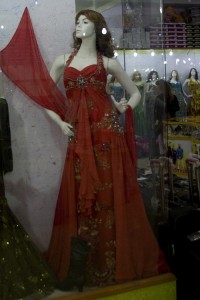
jackets (for modesty), Chador cloth and lounge wear. It was so odd to see those things selling side by side. Inside one shop, my companions wanted to try on one of the jackets in the window, so the sales clerk obligingly pulled one of the manikins out of the window display by putting one hand in her crotch and the other on the shoulder. Then he disrobed her, handing the jacket to my friend to try on, leaving the blue jean-clad but bare breasted model out for the entire rest of the time we were in the shop.
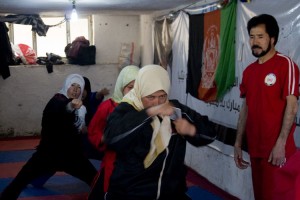
I’ve encountered other contradictions to “common understandings” here and there. The other day I interviewed five students from a Tai Kwan Do class taught by a male instructor. This fellow has taught over 700 girls in his tiny dojo, with some of them wining prizes in international competitions. He instructs them all for free, earning his living from teaching the boys. Some of these girls heard about the class and asked their parents for permission, but in other cases, the parents found out about the class and encouraged their daughters to join, in spite of having a male instructor. I had come across these girls performing (and being filmed for TV) at a Women’s Day event and chased them down for an interview.
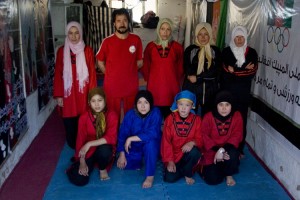
I also interviewed Elaha Surur, a former contestant on Afghan Star. (It’s the Afghan version of American Idol.) She talked about the negative repercussions her TV performance had on her family, how most of her relatives no longer speak to her parents. She now lives in a 3-room house with her sister. When I arrived for the interview, her “friend” was there and he filled in bits and pieces in the interview. Later, when I asked her to sing, she called another friend to accompany her on guitar.
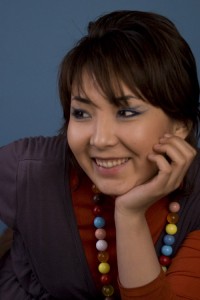

Posted in Afghan Women's Project, AWP 2010, Other, women | 1 Comment »
Herat part 1
March 25th, 2010
Just back from a short trip to Herat, an ancient cultural center located on the Harīrūd river in western Afghanistan. First settled five thousand years ago, Herat has always been regarded as the cradle of Afghan civilization, Like in Egypt, as one flies over sandy wastelands, a straight line changes the landscape to one of irrigated green fields and trees.
Shakila, the woman who visited us last summer invited me to spend the Now Ruz (New Year) holiday with her old friend from nursing school, Soleha, her husband Ali, and their 4 year old daughter, Munis. They live in a nice apartment with gorgeous pink marble stairs, two bedrooms, a “squat and squirt” toilet and no internet. Soleha has become a midwife and has opened her own midwife clinic/pharmacy. (One item she sells at the pharmacy is Happiness brand Depo Prevara.) She cares for her family during the day until 4pm when she opens her clinic. Assistants at the clinic watch Munis while she works. The day Shakila and I visited, she had a non-stop flow of patients for pre-natal care, birth control, gyn issues and post-partum check ups. Lab work takes weeks to return and she doesn’t do routine pap smears. She says that the women prefer her to a doctor because she takes the time to listen to them and if she doesn’t know something, she works hard to find out.
The following day we went touring around. The mosque and seminary complex completed by Queen Gowhar Shad in 1418 is now rubble with only five towering pillars remaining. Among the dirt hillocks and low mud brick walls remaining, heroin addicts have fashioned huts out of rubble.
Gazar Gah is the burial place of Ansari of Herat, a renowned and well-loved Sufi poet who died in 1088.
Here is one of his poems:
Give Me
 |
by Khwaja Abdullah Ansari (1006 – 1088) TimelineEnglish version by Andrew Harvey Original Language |
|
O Lord, give me a heart
I can pour out in thanksgiving.
Give me life
So I can spend it
Working for the salvation of the world.
Inside this shrine and others also offer an oasis where women can gather to visit with each other in this conservative city where there are few places for women to “hang out” in public.
Next we visited the Haji Galton Wali shrine, also known as the shrine of the “Rolling Saint”. When I visited here in ’03, it was full of men and I was told to come back on a “women’s day”, which I couldn’t do. This day there were only a few people, so I took the opportunity to give it a try. My attitude was that I don’t believe in it, but I don’t disbelieve, either. I lay my head on a stone for that purpose, crossed my ankles, made a wish and the shrine-lady there gave me a push to start me rolling. It didn’t really work. The few rolls I did took effort. I took that to mean that I wasn’t going to get my wish. I changed wishes and this time once I got started, it felt as though I were rolling down a gentle hill. I came to a stop in the middle of the “yard” and wondered if I could roll more so I tried to continue to roll under my own effort. This time it was hard, not natural like the rolling was earlier.
Posted in Afghan Women's Project, AWP 2010, women | Comments Off on Herat part 1
Business Student Interviews
March 18th, 2010
My head is swimming from transcribing the interviews of four students of the IEEW. (The Institute for Economic Empowerment of Women, www.ieew.org)
When I listened to Rahela describe her yard-long list of activities that she had done over the years to provide education, health and employment services for women, I was wondering what anyone in the West would have to teach her. What she (and others) appreciate about what IEEW and other business training organizations have to teach are the mechanics of organization, writing business plans, self-promotion, “wayward employee” management and things like these which aren’t part of Afghan culture.
Throughout all of the interviews I’ve done with these women and others, there is the common theme that they are who and what they are because of the support they got from their families. And they feel a need to pay it back. Farghana says that her dream for herself is to be an internationally known successful businesswoman, but also “I would be a woman who will take her family along with herself. I know my power,… but I think that my family is my backbone”.
Sometimes they had to fight for that support and prove themselves, like Miriam, a photojournalist, whose father wouldn’t let her travel to Herat with a female foreign colleague. She “worked on him” for awhile until he got used to that idea and later the idea of her living alone in another town on another assignment, then to take a photo course in India, and etc. etc. At this point, when she’s not home by 9 PM, (which is generally unacceptable for women in Afghanistan) he will call her to make sure she’s safe, but he trusts that she’s doing important work. It helps that she’s bringing in a good income.
What finally convinced him is that she told him that when she’s out photographing, interviewing and interpreting, no one sees her as a woman, that they see her as a man because of the way she acts and talks. Really, these fathers are taking a big chance in a society where even rumors of their daughter’s unacceptable behavior can land the woman and by extension their families in serious trouble, if not even prison. I’m seeing that often this “trouble” comes from conservative relatives.
And it’s not only the fathers. Those who are married, must necessarily have accepting and supportive husbands, and not always pertaining to the women bringing in an income. When Sakina and her friends organized the demonstration against the Shia Family Law (in the West more famously known as the Hazara Marital Rape Law), “my family supported me. Especially my husband, because we are like friends.”
Another benefit of that demonstration for her and her friends was the example of how powerful women working together can be. There are many cases of women doing things and creating organizations to help those less fortunate, but many who participated, felt as Sakina did, that “when we make contact with another woman and share ideas and our skills, we can improve ourselves.”
Posted in Afghan Women's Project, AWP 2010, education, women | 1 Comment »
Reconciling with the Taliban
March 12th, 2010
3-11-10
My purpose in this blog is to be your eyes and ears on the ground, to report what I see and hear. My agenda is to seek out things that are going right, that are working, that can give one cause to hope that in a few years or decades, life for Afghans will be improved. This must also be balanced with other things I see that go in the opposite direction. Afghanistan is a perfect example of the story of the elephant and the blind men who, each feeling a part of the elephant and suppose it to represent the entire animal. I will share the bits and pieces that I discover and leave it to you to draw conclusions, knowing that even this is but a small window into the entire scene.
We met with Professor Akhram of the National Independence Peace and Reconcilliation Commission whose plan for peace is to integrate Afghan Taliban into society. First, he divides Taliban into the (bad) Pakistani Taliban and the (mostly good) Afghan Taliban. Five years ago he (and his cohorts) began meeting with 23 thousand tribal elders all over the country. These elders know how to talk with the villagers to persuade them not to send their kids to join the Taliban and to persuade the Talibs from their villages to give up fighting and join the peace movement. Of the nine thousand who turned in their weapons, 25 of them were high-level Taliban. Those who join get a paper stating their new status which they can present to US soldiers in order to avoid trouble with them. He claims that 85% of the Afghan Taliban are reconcilable, that they agree to schools for girls (as mandated by Islam) and for women to work outside the home. This last is a moot point in the villages.
The downside is the 6,000 Pakistani Taliban (out of 30,000) who are interfering with this peace process and who are funded and controlled by the Pakistani ISI (intelligence service). The Taliban in Marja are of this sort.
We got to meet with Professor Ramani, an ex-Talib, third or fourth from the top, who is now a senator in the parliament. He believes in women’s rights to school and says that as long as the religious conditions are met, women should be allowed to work. He himself has no problem working with women. He said that many of the Taliban excesses were from “wrong thinking because of war times”.
I got to meet with Prof. Akhram a second time and when I mentioned Prof. Ramani to him, he said that he didn’t trust him because he has property in Islamabad, Pakistan, and a whole network of Pakistanis.
When I asked the house guard here at the guest house, he told me that most of even the Afghan Taliban are “bad guys”. Others say that unless they are integrated into society and given jobs, there will be no peace.
I will be asking about this throughout my other interviews.
Posted in Afghan Women's Project, AWP 2010, Other, political, Taliban | 2 Comments »
